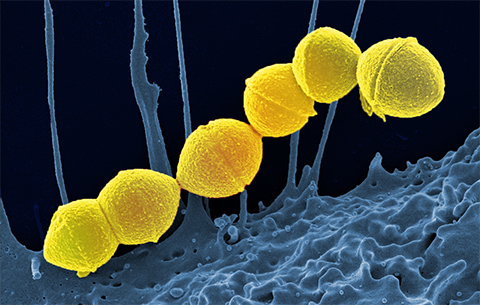Quantifying how proteins in microbe and host interact
Antimicrobial resistance is a growing problem around the world. When microbes such as bacteria, viruses, parasites and fungi stop responding to antimicrobial medicines, most researchers respond by working to develop new vaccines. However, when host proteins bind to bacterial proteins, that binding masks some dominant antigenic sites on the pathogen. Because of this, traditional vaccines have seen poor antibody responses.
In a recent study published in the journal Molecular & Cellular Proteomics, researchers at Lund University used affinity purification combined with quantitative mass spectrometry, or AP-MS, techniques to investigate if these bacteria and host protein–protein interaction networks could compromise the development of protective antibody responses; they used Streptococcus pyogenes, a bacteria that causes infections in humans,as a model system.

Johan Malmström was the corresponding author of this study. “To develop better vaccines, we need new methods and a better understanding of the antibody responses that develop in immune individuals,” he said.
Streptococcus pyogenesbelongs to Group A Streptococcus, or GAS, which affects about 18 million people annually, and claims over 500,000 lives, so an urgent need exists for a vaccine against GAS.
In previous work, Malmström’s lab has shown that GAS forms extensive protein interaction networks with human proteins, so they wanted to analyze the association between the antigen-specific antibody responses and the host protein–bacterial protein interactions. They also wanted to understand if antigen-specific antibody responses could affect these protein networks to understand antibody repertoire (the entire set of antibodies produced in an individual), ultimately aiding the development of effective vaccines against GAS.
In this study, the researchers immunized mice with the conserved M1 protein from GAS and showed that mouse plasma protein forms similar protein networks with the bacterial M1 protein as those seen in humans. Using AP-MS, they quantified the competition among antibodies and protein interaction networks.
While the team found that the antigen targeted by the anti-M1 antibodies affected sites outside the protein interaction surfaces and could not outcompete these interactions, they also discovered in this study that regions in bacterial proteins within protein-interaction interfaces are more challenging to develop antibodies against, highlighting the need to quantify and assess these interactions.
Several bacterial pathogens use their surface proteins to interact with the host proteins to dodge the immune system and mask their dominant epitopes.
The experimental strategy developed in this study can measure the level of competition between antibodies and host plasma proteins at the same bacterial sites, thereby dictating the course of host immune responses. This method could be broadly applicable to any type of bacterial protein.
“I think that the most efficient way forward would be to build networks of scientists with different research skills and meet around the same problem,” Malmström said.
Read more about this group’s research here.
Enjoy reading ASBMB Today?
Become a member to receive the print edition four times a year and the digital edition monthly.
Learn moreGet the latest from ASBMB Today
Enter your email address, and we’ll send you a weekly email with recent articles, interviews and more.
Latest in Science
Science highlights or most popular articles

Exploring the link between lipids and longevity
Meng Wang will present her work on metabolism and aging at the ASBMB Annual Meeting, March 7-10, just outside of Washington, D.C.

Defining a ‘crucial gatekeeper’ of lipid metabolism
George Carman receives the Herbert Tabor Research Award at the ASBMB Annual Meeting, March 7–10, just outside of Washington, D.C.

The science of staying strong
Muscles power every movement, but they also tell the story of aging itself. Scientists are uncovering how strength fades, why some species resist it and what lifestyle and molecular clues could help preserve muscle health for life.

Bacteriophage protein could make queso fresco safer
Researchers characterized the structure and function of PlyP100, a bacteriophage protein that shows promise as a food-safe antimicrobial for preventing Listeria monocytogenes growth in fresh cheeses.

Building the blueprint to block HIV
Wesley Sundquist will present his work on the HIV capsid and revolutionary drug, Lenacapavir, at the ASBMB Annual Meeting, March 7–10, in Maryland.

Gut microbes hijack cancer pathway in high-fat diets
Researchers at the Feinstein Institutes for Medical Research found that a high-fat diet increases ammonia-producing bacteria in the gut microbiome of mice, which in turn disrupts TGF-β signaling and promotes colorectal cancer.

